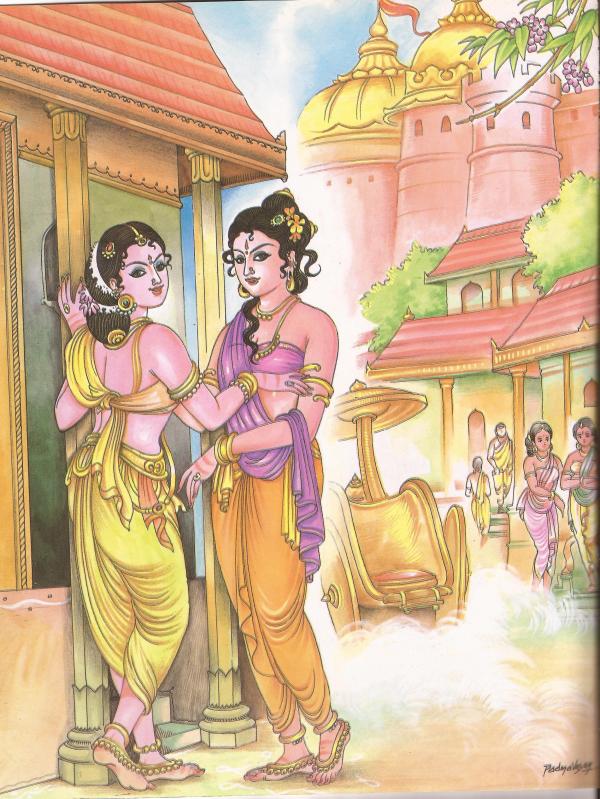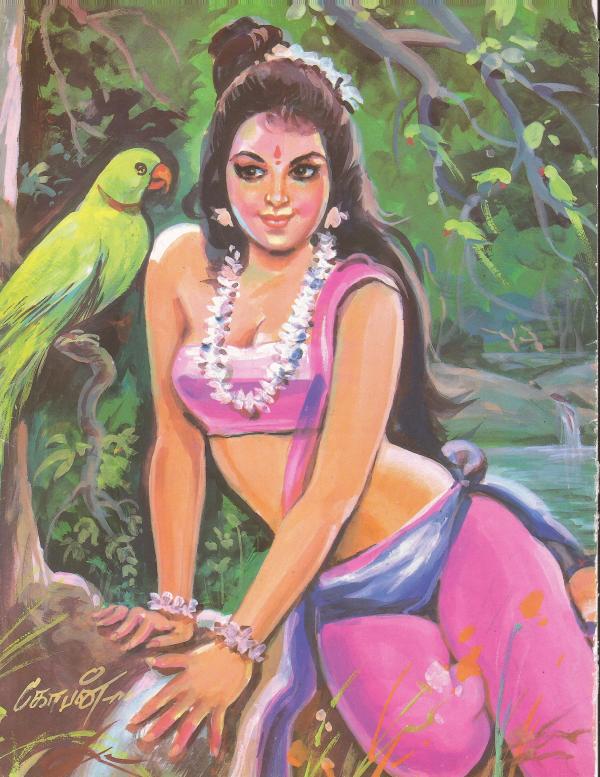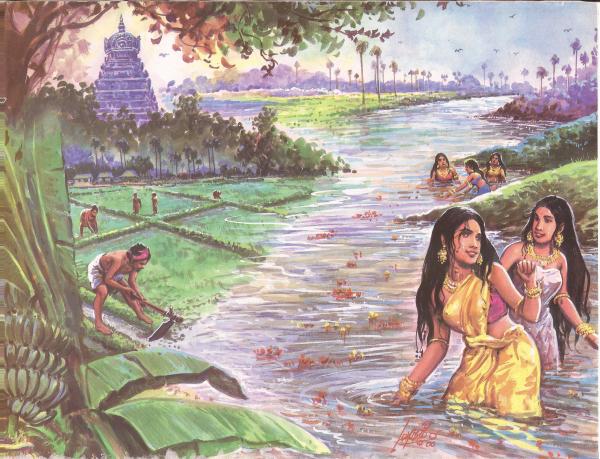
A community’s development can be easily measured by the level of women’s education or status. If we take all the ancient cultures into account, India has a unique place in the world. Lot of countries gave women-- education, freedom, right to inherit property, right to attend religious ceremonies and a status ---several centuries after ‘India that is Bharat’ gave them.
Vedas and Sangam Tamil literature have the highest number of women poets (poetesses) in the world. It is amazing to see they were able to compose poems and attend assemblies. Gargi Vachaknavi was the only example one can quote for women’s education and freedom from the most ancient days. She was invited to attend an assembly of scholars to discuss philosophical matters. King Janaka of Videha convened the conference. It happened at least 3000 years ago. Even the foreign scholars, who always underestimate and underrate anything Indian, gave the date 800 BC for the Brihad Aranyaka Upanishad, where Gargi appears for the first time. Gargi, a great philosopher, not only attended the conference, but also challenged the most revered philosopher of the day, Yajnavalkya.
Thousand years later, the grand old dame of Sangam Tamil literature Avvaiyar appeared on the scene. She was able to attend the great assembly of the three most powerful kings of the Tamil speaking world-- Chera, Choza and Pandya. The occasion was the great Rajasuya Yajnam done by Choza king Peru Nar Killi. She praised them for their unity and wished them long life. She was able to enter any palace without a permit or visit any country without a visa. Poets and ascetics had more rights than the diplomats of the modern world. They can challenge the kings in the assemblies and question their misbehaviour.
We have over 25 Vedic poetesses and over 25 Tamil Sangam poetesses. No culture in the world had so many poetesses 2000 years ago. It was a world dominated by men. Law giver Manu said that a community will be destroyed if women are not respected.
Indian women were so intelligent that they can easily solve knotty problems. A boy wanted to study Vedas. But he knew only his mother Jabala. When he went to the teacher he asked what was his Kulam, Gotra (clan and sub sects), names of parents etc. He replied truthfully that his mum asked him to give the mother’s name only as Jabala. The teacher was so impressed by his honesty, he took him immediately as his student. He gave the boy a new name-- Satyakama (one who seeks truth) Jabala.
Vedic and Sangam Tamil period women did not sing only about Gods and Kings. They sang about everything in the world. Women like Draupadi and Kannaki challenged the most powerful kings of the day. They vowed to destroy injustice and they did it. Women like Damayanti and Savitri fought for their husbands and won the cases. Sita and Mandodari, wives of rivals, were praised for their chastity. They will inspire women for generations to come.
In Vedic days, women were teachers as well. Panini, the first and foremost grammarian in the world, explains the distinction between acaryaa and acaryani, upadhyayaa and updhyayini.

Manu, author of the great law book Manava Dharma Shastra, says,
‘’women must be honoured and adorned by their fathers, brothers, husbands and bothers-in-law, who desire their own welfare. Manu 3-55
‘’Where women are honoured, there the gods are pleased; but where they are not honoured, no sacred rite yields rewards. Manu 3-56
Where the female relations live in grief, the family soon wholly perishes; but that family where they are not unhappy ever prospers. 3—57
The houses, on which the female relations, not being duly honoured, pronounce a curse, perish completely, as if destroyed by magic’’ Manu 3-58
Hence men, who seek their own welfare, should always honour women on holidays and festivals with gifts of ornaments, clothes and dainty food. 3-59
Sanskrit and Tamil literature even entered the magic or the superstitious world to show that chaste women can do miracles. They can bring fire and rain by their power. But women never abused their powers. Sita says to Hanuman, the first International ambassador, that she can burn the 14 worlds with her power, but she wanted her husband to take the credit of finishing the demon king Ravana of Sri Lanka.
Great poet Valluvar went one step further and says that any chaste woman has the power to make rain at her bidding (Kural 55)
Seeing Arundhati Star
Arundhati: Wife of great ascetic Vashista. Symbol of faithfulness, symbol of Indian womanhood and astral goddess in the Saptarishi Mandalam (Great Bear Constellation in the Northern Sky). Every Hindu must see the star on the First Night in the sky. She was the most praised woman on earth. 5000 year old Vedas and 2000 year old Sangam Tamil literature praised her sky high.
Manu says
‘’Akshamala, a woman of the lowest birth, being united to Vashista and Sarangi (being united) to Mandapala became worthy of honour’’(4-23).Akshamala=Arundhati.
Sangam Tamil literature refers to Arundhati in several places: Ainkuru.442; Puram.122; Kali.2-21;pari 5-44, madu.610.
In the later days we have great women poetesses like Karaikal Ammaiyar,
Andal, Gangadevi , Mirabhai and Lalleswari.
Two thousand years ago Hindus believed in the same values from Kashmir to Kandy in Sri Lanka. This is another blow to the racists who advocated Aryan Dravidian Race Theory.

Here are the Lists of Vedic and Sangam Tamil Poetesses:
Aditi, Apala, Dakshina, Gosha, Indrani ,Juhu, Kadru, Lopamudra, Ratri, Romasa, Sasi, Sashvati, Sikandini kashyapi, Sraddha, Sarama, Sikta, Sudevi, Surya, Sarasvati, Ushas, Urvasi,Visvara, Visvruha, Vispala, Vakambhirini, Vachukra’s wife, Vac, Yami
From Sama Veda – Nodha, Agnishta basha, Sikatani vavari, Ganpayana,
Later day great women—
Gargi vachaknavi, Maitreyi, Nalayini, Savitri, Kaikeyi, Sita, Mandodari, Ahalya, Arundhati, Kunti, Draupadi. (Kaikeyi was a great driver. She rode the chariot when Dasaratha went to war with the demons and defeated them)
Tamil Poetesses
(Like Rig Vedic compiler Vyasa, Tamils also followed Vyasa’s technique of naming anonymous poets with abstract expressions. So we don’t know for sure how many poetesses were there in Vedic period or later. But poetesses were there, which is confirmed by later day mythologies. Slight change of spellings or some suffixes to names made enthusiasts to count more number of poetesses!! One surprising thing about Sangam Tamil names is most of them have prefixes like Sanskrit names Su=Nal. Lot of poetess’s names have this Nap or Nal prefix.
This shows ancient Indians followed the same method in naming. I have already written about the Sanskrit names among Sangam Tamil poets such as Valmiki, Damodaran, Markandeyan, Kamakshi, Kesavan, Mahadevan, Nagarajan,Paliyathan,Vishnu dasan, Kannadasan etc.
1.Avvaiyaar 2.Aadimanthiyaar 3.Anjil anjiyaar 4.Uunpiththai
5.Kaamakkanipsalaiyaar 6.Kaavarpendu 7.Kuramakal kuriyeyini
8.Maarpiththiyaar 9.Maasaaththiyaar 10.Nachchellaiyaar 11.Nakkannaiyaar
12.Nedumpalliyathai 13.Nalvellaiyaar 14.Nalveliyaar 15.Nanmullaiyaar 16.Nappasalaiyaar 17.Naagaiyaar 18.Paari makalir 19.Perungkoppendu
20.Peymakal ilaveyini 21.Ponmaniyaar 22.Ponmudiyaar 23.Puunkan uththiraiyaar 24.Pullaankanniyaar 25.Vennik kuyaththiyaar 26.Velli viithiyaar
27.Venpuuthiyaar 28.Kakkaipaadiniyaar.
Pictures are taken from World Tamil Souvenire;thanks.

